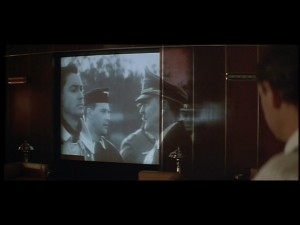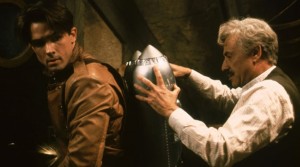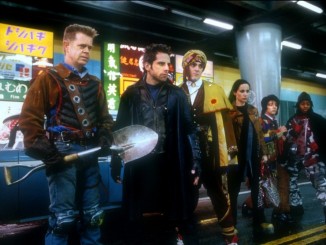In a multi-part series, Comic Book Film Editor William Gatevackes will be tracing the history of comic book movies from the earliest days of the film serials to today’s big blockbusters and beyond. Along with the history lesson, Bill will be covering some of the most prominent comic book films over the years and why they were so special. This time, we’ll look at the comic book film that failed upward—The Rocketeer—and the comic artist that created the original source material—Dave Stevens.
Some comic book creators are incredibly prolific with the amount of characters they create, say, like Stan Lee and Jack Kirby. Others are primarily known more for their artistry than the characters they create, like George Pérez. But in Dave Stevens’ case, he was known for his artistry and the one character he created. That character is the Rocketeer.
 Stevens got his start in the mid-1970s as an assistant to the legendary Russ Manning while Manning was doing the art for the Tarzan and Star Wars comics strips. He then went on to work for Hanna Barbera under the tutelage of Jonny Quest creator Doug Wildey and also worked some as a storyboard artist.
Stevens got his start in the mid-1970s as an assistant to the legendary Russ Manning while Manning was doing the art for the Tarzan and Star Wars comics strips. He then went on to work for Hanna Barbera under the tutelage of Jonny Quest creator Doug Wildey and also worked some as a storyboard artist.
At the 1981 San Diego Comic Con, Pacific Comics owners, the Schanes brothers, came to Stevens for help because they knew he was an artist. They needed two, six-page stories to act as filler in issues #2 & #3 for Mike Grell’s creator-owned book, Starslayer. Stevens bounced around some ideas and came up with one that he could do on the fly.
Even though the Rocketeer was thrown together on the spot, it didn’t mean that it was amateurish or awful. On the contrary, it is one of the best works to come out of comic books in the 1980s.
 The series was a bouillabaisse of Stevens’ likes and influence. He used himself as a model for the hero, Cliff Secord. His mentor Wildey became the model for Secord’s mentor, Peevy. Stevens’ muse Bettie Page became the model for Cliff’s girlfriend, Betty. Nods to everything from Doc Savage (Doc’s assistants Ham and Monk appear anonymously in the first Rocketeer installment), The Shadow (who helps Cliff in the second), Rondo Hatton (who is the basis for the villain of the second installment), the film Freaks, the aviation trend of the depression era, film serials, the kitchy architecture of pre-war Los Angeles and the glamour of 1930s Hollywood and New York City.
The series was a bouillabaisse of Stevens’ likes and influence. He used himself as a model for the hero, Cliff Secord. His mentor Wildey became the model for Secord’s mentor, Peevy. Stevens’ muse Bettie Page became the model for Cliff’s girlfriend, Betty. Nods to everything from Doc Savage (Doc’s assistants Ham and Monk appear anonymously in the first Rocketeer installment), The Shadow (who helps Cliff in the second), Rondo Hatton (who is the basis for the villain of the second installment), the film Freaks, the aviation trend of the depression era, film serials, the kitchy architecture of pre-war Los Angeles and the glamour of 1930s Hollywood and New York City.
Stevens gets the reputation of being a “good girl” artist for his skill at drawing gorgeous women in seductive poses, but his artistry goes way beyond that. Certainly, his art was beautiful when he was illustrating buxom babes, but it was just as beautiful when he was drawing an airplane, a supper club, or the folds on a dinner jacket. His art was lush and detailed and seemed to have a glow all of its own.
And his writing was also ahead of its time. Cliff Secord could have been a precursor to the “anti-hero” trend that Alan Moore and Frank Miller would exploit several years later. Secord was stubborn and self-centered. He was jealous and had a quick temper. He wasn’t the prototypical superhero, all virtuous and noble. He was human, like us.
 The Rocketeer saga was presented in two installments in eight separate issues of four different series (Starslayer, Pacific Presents, The Rocketeer Special Edition, and The Rocketeer Adventure Magazine) from four different publishers (Pacific, Eclipse, Comico, and Dark Horse) over the span of 13 years (1982-1995). The protracted publishing schedule was due mainly to the fact that two of the four comic companies went out of business while he was working with them, his own meticulous drawing speed, and various legal entanglements (for instance, the rights for The Rocketeer were mistakenly listed as an asset of Comico when they went bankrupt, so Stevens had to wait six years after issue #2 of The Rocketeer Adventure Magazine, which was published by Comico in 1989, before he could publish the final issue of the series at Dark Horse in 1995 after the new holder of Comico’s rights itself went out of business as to avoid a legal battle over the disputed rights.)
The Rocketeer saga was presented in two installments in eight separate issues of four different series (Starslayer, Pacific Presents, The Rocketeer Special Edition, and The Rocketeer Adventure Magazine) from four different publishers (Pacific, Eclipse, Comico, and Dark Horse) over the span of 13 years (1982-1995). The protracted publishing schedule was due mainly to the fact that two of the four comic companies went out of business while he was working with them, his own meticulous drawing speed, and various legal entanglements (for instance, the rights for The Rocketeer were mistakenly listed as an asset of Comico when they went bankrupt, so Stevens had to wait six years after issue #2 of The Rocketeer Adventure Magazine, which was published by Comico in 1989, before he could publish the final issue of the series at Dark Horse in 1995 after the new holder of Comico’s rights itself went out of business as to avoid a legal battle over the disputed rights.)
In 1991, before the final issue of the series was published, The Rocketeer was released in theaters.
 The Rocketeer really has no business being on the list of the best comic book adaptations ever made. The film was first optioned in 1983 by Steve Miner in an aborted attempt to bring it to the screen, but differences in the direction the film property should go caused the film rights to revert back to Stevens. The artist found a more comparable match with Danny Bilson and Paul DeMeo, who were on the same page as Stevens as to subject matter and setting of the film.
The Rocketeer really has no business being on the list of the best comic book adaptations ever made. The film was first optioned in 1983 by Steve Miner in an aborted attempt to bring it to the screen, but differences in the direction the film property should go caused the film rights to revert back to Stevens. The artist found a more comparable match with Danny Bilson and Paul DeMeo, who were on the same page as Stevens as to subject matter and setting of the film.
The film originally landed at the Walt Disney shingle, Touchstone Pictures and had a tone similar to the original comic book story. However, Disney executive Jeffrey Katzenberg, knowing that the kid-friendly Disney studios needed a live-action hit and seeing the potential in the film as a toy generating property, moved the film over to the main studio. As a result, nude model Bettie Page became aspiring starlet Jenny Blake, and Cliff Secord went from being an irascible rogue to an all-American kid with just a hint of the rebel in him.
 Usually, when this big of a change is made in the translation to the screen, the film suffers. But while the concept was lightened to make it more family-friendly, it still kept the spirit of the original comic alive. It helped that Dave Stevens kept a hands-on role all through production. He provided his clip files to production designers to properly capture the look of the time. Stevens has a cameo as the German test pilot for their version of the rocket pack.
Usually, when this big of a change is made in the translation to the screen, the film suffers. But while the concept was lightened to make it more family-friendly, it still kept the spirit of the original comic alive. It helped that Dave Stevens kept a hands-on role all through production. He provided his clip files to production designers to properly capture the look of the time. Stevens has a cameo as the German test pilot for their version of the rocket pack.
The film was a tribute to depression-era Los Angeles and a love-letter to the culture of the barnstorming pilot. It still paid homage to the age of the film serial, but added nods to the B-movie gangster, espionage and crime genres. And as much attention as Stevens’ paid to the look, the architecture and the illustration style of the era, director Joe Johnson paid as much attention to the visual style of the films of the 30s.
 Some plot points still made the translation over from the book to the film. The origin is still pretty much the same as the book, as is Secord’s first appearance as the Rocketeer (although he is rescuing a pilot in the film who has lost control of his plane, not a pilot who has passed out behind the yoke because he was drunk, as in the book. Thank you Disney!). The Rondo Hatton look-a-like Lothar, the main villain from Stevens’ second arc, is in the film, but as a henchman for the main villain, Neville Sinclair, a new addition as “the number three box office star in America” who is a Nazi spy. Yes, the Nazis are still after the rocket in the film, but in a less straightforward way than in the book. They try to get the rocket through Sinclair who tries to get it through some local gangsters.
Some plot points still made the translation over from the book to the film. The origin is still pretty much the same as the book, as is Secord’s first appearance as the Rocketeer (although he is rescuing a pilot in the film who has lost control of his plane, not a pilot who has passed out behind the yoke because he was drunk, as in the book. Thank you Disney!). The Rondo Hatton look-a-like Lothar, the main villain from Stevens’ second arc, is in the film, but as a henchman for the main villain, Neville Sinclair, a new addition as “the number three box office star in America” who is a Nazi spy. Yes, the Nazis are still after the rocket in the film, but in a less straightforward way than in the book. They try to get the rocket through Sinclair who tries to get it through some local gangsters.

While the film does not follow the book exactly, if you buy into the goofy homage to the entertainment of the past, the film becomes an entertaining ride. I still cheer at the jingoistic way the mobsters, who were trying to kill Secord and the feds throughout the whole movie, switch allegiances to fight the Nazis at the end.

The film is as good as it is due to two actors in particular, and not the ones who would later go on to win Oscars either. Alan Arkin, who would win Best Supporting Actor in 2007 for Little Miss Sunshine, is miscast in the role of Peevy. Arkin is too laid back in the role of the grumpy genius from the comic. And, although this might not be his fault, he is cursed with one of the worse hairpieces ever to appear on recorded film. I kept expecting birds to use it as a nest.
Jennifer Connolly, who would win Best Supporting Actress for A Beautiful Mind in 2002, was still relatively early in her film career. She had not at that point gained the acting chops that would later win her the Oscar. You get the feeling that Jenny was written as a glamorous yet down to earth girl with a lot of moxie. Connolly played her as a glamorous yet down to earth girl with very little moxie to her.

However, Billy Campbell and Timothy Dalton are what make this movie great. Campbell looks almost exactly like the comic book Cliff Secord, and the relative newcomer brought a Jimmy Stewart-like charisma to the role. And Dalton, who was just coming off a stint of playing James Bond, excels as the Errol Flynn-inspired Neville Sinclair. He puts so much life into the villain that it becomes a truly complex character. Dalton’s Sinclair is charming one minute, dangerous the next, and funny the minute after that, with just the right amount of scenery chewing thrown in for good measure.
The film was originally planned to be the first in a trilogy, but when the $35-40 million dollar film only made $46+ million at the box office, that plan was scrapped. Although it wasn’t a financial success, it was a charming film. And while it wasn’t 100% faithful to the comic book, it showed a comic book movie is best when they capture the spirit of the original source material.
While many, including myself, think this version is pretty much close to perfect, there are people in Hollywood who still think “pretty close” isn’t close enough. As we reported here, rumor has it that Disney is are thinking of remaking the film. Personally, I hope the make a more adult version of the property, more in line with Stevens’ excellent original comic book.
Next, we cover another great comic book adaptation whose behind-the-scenes tragedy raises it above your standard comic book film.




